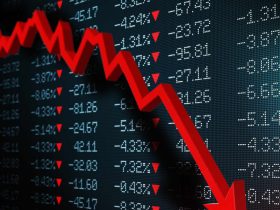The yield on the 30-year Treasury bond briefly rose above 5% on Wednesday amid political chaos in Washington, then dipped after U.S. private-sector employment data missed expectations.
What’s happening
-
The yield on the 2-year Treasury
BX:TMUBMUSD02Y
slipped 6.4 basis points to 5.084% from 5.148% on Tuesday. -
The yield on the 10-year Treasury
BX:TMUBMUSD10Y
dropped 5.4 basis points to 4.747% from 4.801% Tuesday afternoon. Tuesday’s level was the highest close since Aug. 8, 2007, according to 3 p.m. Eastern figures from Dow Jones Market Data. -
The yield on the 30-year Treasury
BX:TMUBMUSD30Y
fell 6.7 basis points to 4.869% from 4.936% late Tuesday after briefly touching 5.015%. The 30-year rate finished Tuesday’s session at its highest since Sept. 20, 2007.
What’s driving markets
Data released on Wednesday showed that U.S. private-sector employment rose by a tepid 89,000 in September, the smallest increases in 2½ years. Economists polled by The Wall Street Journal had forecast a gain of 150,000.
Yields broadly fell after the report, which suggested softening in the labor market, though it isn’t an accurate predictor of the official September jobs report which is set for release on Friday.
U.S. government bonds have been under severe pressure in recent weeks after recent better-than-expected economic data encouraged Federal Reserve officials to continue their hawkish rhetoric, pencil in another interest rate hike this year, and keep borrowing costs elevated for longer. Job openings data for August, released on Tuesday, exacerbated those fears.
Earlier on Wednesday, as European traders got to their desks, the trend had accelerated with yields propelled higher by concerns that the first-ever ousting of a Speaker of the House of Representatives presented a picture of dysfunction from the U.S. government.
The 10-year Treasury yield touched almost 4.9% and the 30-year U.S. bond yield briefly moved above 5%. The rate on Germany’s 10-year note
BX:TMBMKDE-10Y,
the eurozone benchmark, also briefly rose above 3% toward its highest levels since 2011.
However, most yields subsequently eased after those initial spikes.
Markets are now pricing in an 81.3% probability that the Fed will leave interest rates unchanged at a range of 5.25%-5.5% on Nov. 1, according to the CME FedWatch Tool. The chance of a 25-basis-point rate hike to a range of 5.5%-5.75% by the subsequent meeting in December is priced at 31.8%.
The central bank is not expected to take its Fed funds rate target back down to around 5% or lower until at least next June or the second half of 2024.
What analysts are saying
“The ADP employment report disappointed expectations, showing that the private sector added 89,000 jobs in September,” said economist Daniel Silver of JPMorgan Chase & Co. “On the surface the ADP report suggests that the BLS data on Friday could disappoint the current expectations, although the ADP report has not been a reliable predictor of the BLS data from month to month (granted last month the August estimates were pretty close). We continue to forecast that the BLS report will show nonfarm employment up 175,000 in September.”
“Leaving aside the loose relationship between the ADP and BLS data, the ADP figures do show a moderating trend for job growth in recent months, which we think is very roughly consistent with what should be going on in the labor market,” Silver wrote in a note.
Read the full article here











Leave a Reply